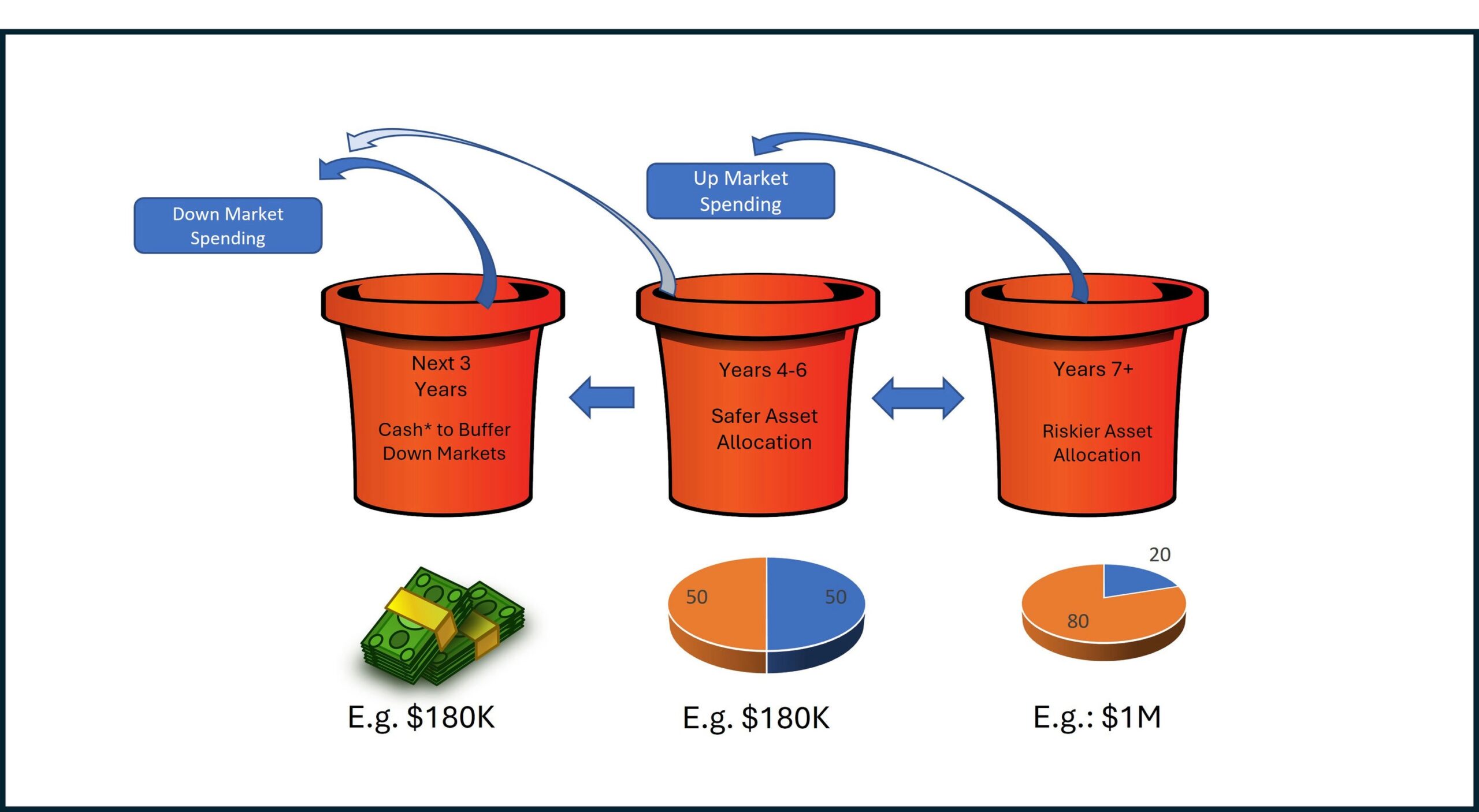Buckets of Cash: Turning Your Nest Egg Into a Paycheck
Retirement is supposed to be relaxing. But watching the stock market pull 9-Gs up its own tailpipe? Not so relaxing. Enter the Bucket Strategy—a way to keep your income steady and your stress level down.
What Is the Bucket Strategy?
Imagine three buckets sitting in front of you. You’re going to fill them with your hard-earned money like a financial picnic:
- Bucket 1 – Cash or cash-like stuff (think: savings accounts, CDs, money markets). This is your “don’t panic” fund—designed to cover 1–3 years of expenses so you’re not selling stocks in a slump.
- Bucket 2 – A mix of conservative investments (bonds, dividend stocks). Think of this as your financial shock absorber—slightly more risk than cash, but still polite and predictable.
- Bucket 3 – Stocks and growth investments. This one’s wild. It’s where the long-term magic (and volatility) lives. Invest it like you’re going to live to 120.
Why Buckets Work
Buckets = Time Segmentation. You spend from Bucket 1, refill it from Bucket 2 or 3 when the market is friendly, and leave Bucket 3 alone to grow over time. You avoid selling low, stay calm during downturns, and let your investments work in peace.
Who Should Use It?
Mostly retirees—but not exclusively. If you’re saving for a house in 3 years, this still works. Use Bucket 1 for the cash you’ll need soon, and let Buckets 2 and 3 grow for the longer-term stuff.
Starting the Strategy
The catch? Most of us aren’t sitting on 3 years of cash. You’ll need to build it up slowly (or all at once if you’ve got the means).
Let’s say a retired couple spends $120k/year but gets $60k from pensions and Social Security. They’d need $60k/year from investments—so 3 years of cash = $180k in Bucket 1.
Where should it live? Try high-yield savings accounts, CDs, money market funds, or multi-year guaranteed annuities (MYGAs, essentially CDs from an insurance company). Basically: safe, boring, and easy to access.
Timing tip: Don’t try to time the market. Yes, it feels good to fill Bucket 1 when stocks are high—but we don’t have a crystal ball. If the market drops and you need cash, filling Bucket 1 can still prevent further damage.
Managing the Buckets
- In good times, refill Bucket 1 using dividends or gains from Bucket 3.
- In bad times, stop touching Bucket 3. Use cash from Bucket 1 instead.
- Try not to touch Bucket 2 or 3 until markets bounce back—ideally to their pre-downturn levels.
- Each year in retirement, reassess. You’re a year older and (hopefully) a bit wiser—maybe you need less cash than before.
If things get really rough and Bucket 1 runs dry, you’ll dip into Bucket 2 (or 3 if needed). That’s why many retirees keep 3–5 years of cash to avoid selling low.
Refilling Buckets
When the market recovers, you’ve got options:
- Refill Bucket 1 using gains from Bucket 3.
- Leave it and let things ride, especially if you’re well into retirement and less worried about long-term volatility.
You probably won’t refill both Buckets 1 and 2—choose based on what matters most: peace of mind or growth.
Pitfalls
- Cash drag: Holding a big cash pile slows growth. If your $1M portfolio includes $180k in cash, the other $820k has to work harder.
- Complexity: One spouse may get it; the other might not. Keep it simple and documented.
- Discipline: You still have to trust the market. Buckets 2 and 3 need to ride out storms—volatility is the price of growth.
Cleared to Rejoin
The Bucket Strategy helps turn chaos into calm. If you’re nearing retirement and want to turn your investments into a steady paycheck, don’t wait for the next market dip—start filling those buckets now.
Your future self will thank you. Probably from a beach chair.
Fight’s On!
Winged Wealth Management and Financial Planning LLC (WWMFP) is a registered investment advisor offering advisory services in the State of Florida and in other jurisdictions where exempted. Registration does not imply a certain level of skill or training.
This communication is for informational purposes only and is not intended as tax, accounting or legal advice, as an offer or solicitation of an offer to buy or sell, or as an endorsement of any company, security, fund, or other securities or non-securities offering. This communication should not be relied upon as the sole factor in an investment making decision.
Past performance is no indication of future results. Investment in securities involves significant risk and has the potential for partial or complete loss of funds invested. It should not be assumed that any recommendations made will be profitable or equal the performance noted in this publication.
The information herein is provided “AS IS” and without warranties of any kind either express or implied. To the fullest extent permissible pursuant to applicable laws, Winged Wealth Management and Financial Planning (referred to as “WWMFP”) disclaims all warranties, express or implied, including, but not limited to, implied warranties of merchantability, non-infringement, and suitability for a particular purpose.
All opinions and estimates constitute WWMFP’s judgement as of the date of this communication and are subject to change without notice. WWMFP does not warrant that the information will be free from error. The information should not be relied upon for purposes of transacting securities or other investments. Your use of the information is at your sole risk. Under no circumstances shall WWMFP be liable for any direct, indirect, special or consequential damages that result from the use of, or the inability to use, the information provided herein, even if WWMFP or a WWMFP authorized representative has been advised of the possibility of such damages. Information contained herein should not be considered a solicitation to buy, an offer to sell, or a recommendation of any security in any jurisdiction where such offer, solicitation, or recommendation would be unlawful or unauthorized.

